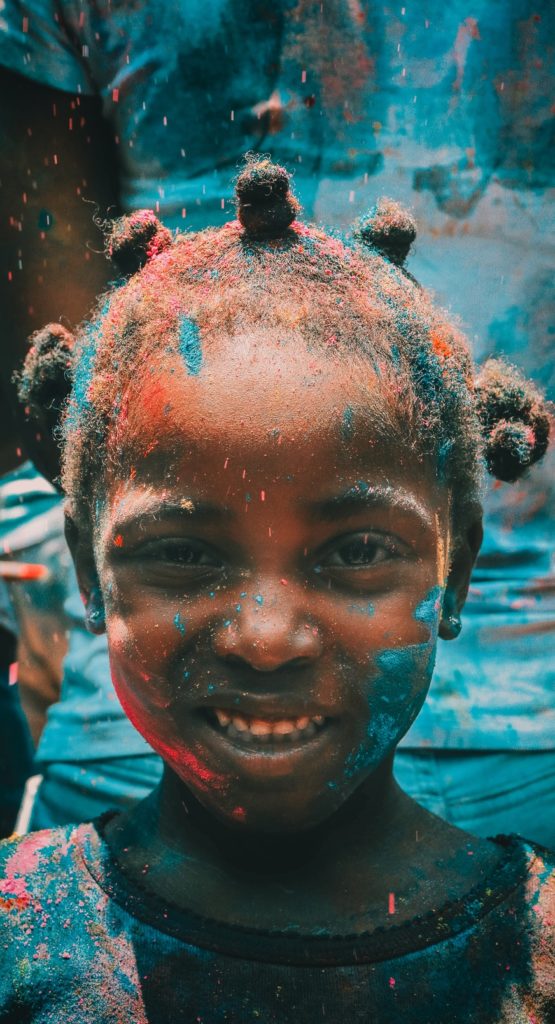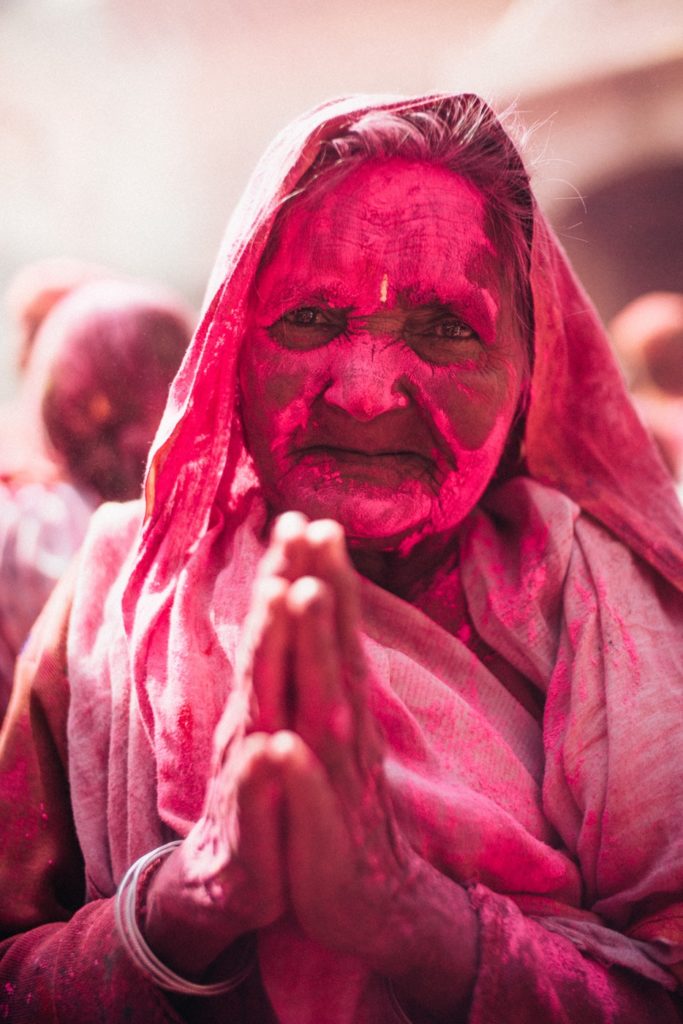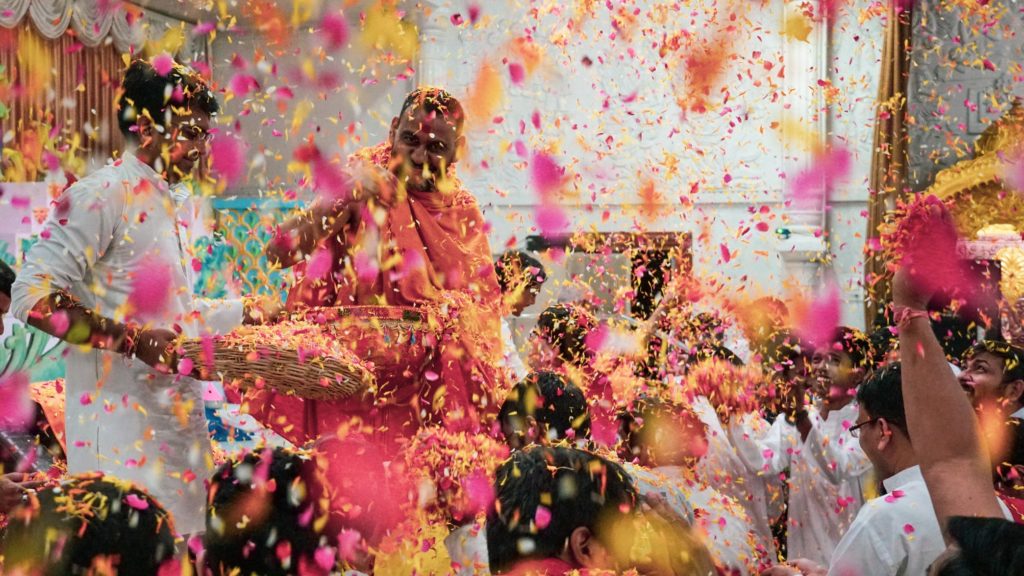The Various Shades of Holi
Holi is the festival of colours which takes place every year in March over two days. If you were in India about a month before Holi, you’d encounter such a colourful vista of Gulaal, Abeer,andRang(all forms of colours made from plant extracts) in the markets that it almost eclipses a rainbow in comparison. You would see that most people would be in a perpetual shopping-frenzy for the entire month. You’d find huge bonfires put up on the cross roads, wood slowly collecting there over the month, ready to be burnt on the eve of Holi.

It is not so much the splash and squirt of water guns and colours that makes this festival so famous. It is the loss of inhibition, the carefree atmosphere to be a certain kind of person and behave in specific manner that makes it so popular.
People usually wear white clothes when the go out to play Holi. By the time they are done, the white is dyed in all possible colours, just as we come in to the world a clean slate, and our experiences colour our imagination and give us our perspectives.
Holi in that sense is as philosophical as is social.
It is a festival where music and colours convey what words fails to do: spread love.
For in the end, what are all festivals meant to do, if not spread love and bring communities closer?
As many festivals around the world find their root in some legend, the festival of Holi does too.
Legend has it thousands of years ago there was an Asura-king (Demon-King) called Hiranyakashyap. As all demons in all mythologies do, he thought himself to be all-encompassing, all-powerful and all-knowing. So much so, he passed a law in his realm that people should worship only him. Anybody defying this law would be punished by death. The realm consisted of Yogis, Rishis (the learned ones) and a populace who strongly placed their belief in Lord Vishnu, the second of the holy trinity of Hinduism.
This law met with a lot of defiance at first. This defiance, as it is with any dictatorial regime, was met with utter violence from the rulers. Hirankashyap was the most powerful asuraof his times and no one in the three worlds had the courage to stand against him. He had the boon that no animal or human could kill him. He would neither be killed in the day, nor in the night, neither inside a building, nor outside of it, neither on land nor in air. No weapon in the world could bring him harm.
He was, for all practical purposes, invincible.
Gradually, the people gave in. New temples were constructed. Hiranyakashyap was installed as the deity. Fear made people worship a demon, a dictator.
All was as he wanted. Rebellion had been quashed.
But rebellion is a tricky worm. It finds a way to crawl its way up back through unimaginable routes.
Hirankashyap had a son, Prahlad. In the ancient Indian education system, children had to stay in the ashramasofRishisto gain an education. So, Prahlad was sent. All these ashramaswere avidly monitored for the worship of Vishnu. These were the centres of rebellion.
And this is how, one day, Hiranyakashyap received the most horrifying news of his life.

His son, his own flesh and blood, was caught worshiping Vishnu at a hidden away temple with other devotees.
He could not stomach this. Prahalad was supposed to take over the kingdom when Hiranyakashyap retired. He was the future. If his own son did not follow his diktats, how would the entire kingdom listen to him?
No, this was to be stopped.
Prahlad was immediately called back home. He was supposed to stay within the four walls of the palace. He was not to interact with the common public. He was restricted in his interaction with the palace staff too.
Prahald came home. A small boy of 12, he followed all the restrictions placed on him to the letter. He would only speak the bare minimum to anybody, would always be respectful and would sit in the palace gardens and chant Vishnu mantras.
It baffled the guards, the ministry, the populace and more than anyone, Hiranyakashyap. How could a young boy of 12 have so much resilience?
Hiranyakashyap cajoled, scolded and then threatened Prahlad with a promise that if he didn’t fall in line, he would meet the same fate as the other rebels.
Prahlad, ever respectful, always answered that he could not stop worshipping Vishnu, for he was the Lord of his father too, and maybe by his penance, Vishnu may forgive his father for his crimes.
Hiranyakashyap was livid. He ordered for his own son to be killed.
They tried poisoning him, it did not work.
They tried throwing him off a cliff, it did not work.
They tried leaving him in the wilderness to be engulfed by the animals and elements, it did not work.
The news spread like wildfire. It was said that the blood in Prahlad’s veins was so pure that the poison couldn’t hurt him. It became the lore that the grace of Lord Vishnu always protected Prahlad.
Hiranyakashyap was on the edge. He was a father who wanted his son dead, and wanted him dead at all costs. Such was his lust for power that he couldn’t stand the idea of his own son living.
It was at this opportune time that Hiranyakashyap’s sister Holika came home.
Now, Holika was a blessed demoness. She had the boon of not being burnt by fire, provided her intentions were rightly placed. She also loved her brother dearly, and saw that her brother was worried and edgy.
On hearing the cause of his worry, Holika said, “Create a huge pyre, brother of mine. I will sit in the middle of it with Prahlad on my lap. You set this pyre on fire. Nothing can survive fire. Not even Prahlad.”
This was an excellent plan.
A huge pyre was set. Holika entered the pyre with Prahlad. Hiranyakashyap set it on fire.
Prahlad sat in the middle of Holika’s lap with folded hands chanting the name of Lord Vishnu with all of his heart.
The flames lapped and licked the wood, gaining height and temperature. Prahlad’s voice gained volume and conviction.
Suddenly the entire atmosphere shook with shrill female cries.
The fire left Prahlad untouched but Holika was burnt to cinders. She had entered the fire with unholy intentions and had paid the price for it.
Hiranyakashyap’s rage knew no bounds.
He pulled Prahlad out of the fire and jostled him, “You killed my sister, you vile son of mine!”
Prahlad calmly replied, “She has found place in the Lord’s lotus feet, Father! My Lord is in everything, even death!”
Hiranyakashyap responded, “Oh so your Lord is in everything? Even this pillar? This pillar??”
He thundered, pointing to the pillar in his court.
“Yes”, replied an ever-calm Prahlad.
Hiranyakashyap raised his hammer-like fist to the pillar and smashed it into two.
And from the rubble came a Lion-man figure, hitherto unseen and unheard of, charging at Hiranyakashyap.
The Lion-man pulled up the Demon-King in one swift blow, dragged him to the court threshold, pulled him in his lap and killed him with his bare hands.
This figure was an incarnation of Lord Vishnu, called the Narsimha, or the Lion-man.
The realm rejoiced the end of tyranny with colours and splashing water.
Prahlad was made the king.
The tradition of setting up bonfires, called the Holika-dahan, is symbolic of the burning of evil.
The playing in colour the next day signifies the happiness and the triumph of good.
But Holi goes much, much further than this. It is the festival has historically brought people of different faiths together. The Holi festival celebrated by Mughal emperor Jehangir is historically famous. Not only the celebrations, but also the Holi poetry written by the 18thCentury Muslim Nawabs and their nobility are still sung as folk songs in the province of Awadh.
In Awadh and Brij, Holi has even more significance than the traditional good and evil balance.
It is the festival of love.
The Hindu God Krishna celebrated Holi with his consort Radha and her friends the Gopis, as the cosmos drowned in their love. According to Hinduism, Krishna is the single focus of dedication for all the Gopis, the natives of Brij.
The modern city of Mathura, which was the kingdom of Krishna, celebrates a form of Holi called, Lattha-Maar Holiwhere wives are free to symbolically beat up their husbands with wooden wands (Latthameans a long wand usually made of bamboo) and the husbands have to protect themselves.
It is symbolic of women being given power in their relationship.
In Vrindavan, the city of birth of Krishna,Phool-wali holi, the Holi of flowers, flowers are played with instead of colours.
As the courts of Mughals and Nawabs were heavily influenced by Krishna culture, it was no wonder Holi played an important role in their functioning.
Holi has historically been the festival that broke the barriers of religion and captured the imagination of masses. It has been a unifying thread for the two most prominent communities of India and the world, the Hindus and the Muslims.
As times changed, the earthy folk music was replaced by the vibrant Bollywood numbers and Holi became a social event. It has inspired colour festivals and colour jams all over the world.
As the Krishna consciousness spread worldwide, and Indian diaspora took roots, Holi found a global presence.
We’ve chosen Holi imagery to represent our theme of diversity for the 2019 University of Sydney Anthology for a good reason. As a festival, it has an incredible depth of history, spanning different cultures, languages and religions. It brings vastly different people together and encourages them to express themselves, be playful, be empowered, and be loved. And, perhaps most importantly, at its core, it has an excellent story to tell.

By Vrishali Jain
To tell your story with words or images, submit a piece to us by the 30thof June. You can submit a prose piece up to 5000 words, or up to 5 pieces of poetry or visual art. To submit, go the ‘submit’ page on the website, link at the top of the page.
 Next Post
Next Post